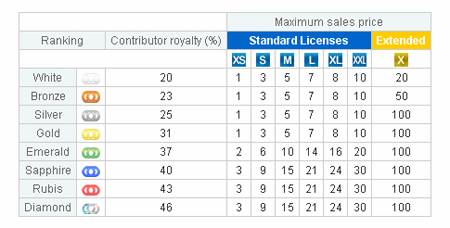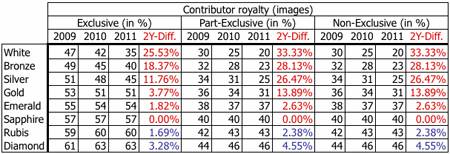Stock Photo News of the Year
2
Today’s post is dedicated to reviewing the news that stock photo agencies have churned out over the past few months of the closing year and the beginning of the new one. But I’ll try to present the information with a bit of originality—after all, it’s the first post of 2011. So, let’s get started:
1) Did you know that top-tier affiliated stock photo sites Shutterstock and Bigstockphoto have launched a joint program cleverly named “Bridge to Bigstock”?
The program’s goal is to promote Bigstock with the help of major Shutterstock contributors. Only the top contributors on Shutterstock will be invited to participate via email. If they agree, all their images from Shutterstock will be automatically transferred to Bigstockphoto.
If a contributor already has a portfolio on Bigstock, the system will filter the content and only add the missing works. Going forward, any new images accepted on Shutterstock will automatically be added to the Bigstock portfolio as well. Everything else remains the same.
Earnings from each stock photo site will be paid out separately, as before. This promo program will certainly make work easier for major contributors who previously didn’t pay much attention to Shutterstock’s smaller sibling. Additionally, this move will significantly expand Bigstockphoto’s image base and give it a push for greater growth.
Too bad I haven’t grown to be a major Shutterstock contributor yet.
By the way, the collection size of Shutterstock has already reached 14 million images. It only took them 2 months to grow from 13 to 14 million!
2) Did you know that in January 2011, the new royalty system that iStockphoto announced last fall came into effect?
Now, iStock’s royalty percentage is tied to the amount of “Redeemed Credits” that customers spent on an author’s images over the past year. This percentage will be recalculated once a year, on January 1st. An author is now guaranteed a certain minimum royalty rate, which can be increased during the annual recalculation. However, the rate will only increase if the “Redeemed Credit” total for the ended year exceeds the total from the year before.
Starting from January 2011, the guaranteed minimum for non-exclusive works is set at 15%, for exclusive works at 25%, and for Vetta/Agency at 22%. The maximum an author can earn for non-exclusive works can reach 20%, for exclusive works 45%, and for Vetta/Agency – 30%. All in all, not great news for contributors. But there’s not much we can do.
By the way, you can see your royalty rate in the “Stats” tab. The “Current” column shows your effective royalty rate for this year.
Furthermore, in the Trending column, you can see your Redeemed Credits – this is the sum of credits earned from sales of your images this year. This amount will be used to calculate your royalty rate for the next year. Your Redeemed Credits will increase with each sale.
Also, in the Royalty Rate column, you can see your projected royalty rate for the next year, calculated based on the Redeemed Credits you’ve earned so far.
The value in the Next Target column shows the level of Redeemed Credits you need to reach the next tier and increase your royalty rate in the coming year.
You can see the full set of contributor royalty rates on iStockphoto on this page: http://www.istockphoto.com/forum_messages.php?threadid=289922&page=1.
3) Did you know that iStockphoto has changed its prices for buyers?
What changed? First, the price of large credit packs has increased. Second, a new 20,000 credit pack has been added. Third, there have been significant price increases for video and Flash content.
Audio content prices remain unchanged. Prices for photos haven’t changed much either, except for an increase in the cost of Medium-sized photos from 6 credits to 7 credits.
Prices for detailed vector illustrations have also changed: non-exclusive ones will cost 12 credits instead of 10, and exclusive ones will be 15 instead of 14 credits. For Exclusive+, prices have also increased from Medium (20 credits) up to XXX Large (50 credits). Overall, this will have almost no effect on my iStock earnings.
4) Did you know that, according to representatives of Dreamstime, fraudulent activities were recently committed by some of Dreamstime’s partner sites?
What are partner sites? These are websites that have agreements with Dreamstime to sell images from the stock agency’s database on their own pages. Dreamstime conducted an audit and found that one of these sites was setting prices for customers who wanted to buy photos and illustrations from the database much higher than stipulated in the contract. Consequently, this hidden difference was pocketed by the owners of the partner site.
Furthermore, it was discovered that some images were cached and sold without Dreamstime’s knowledge. Access to the Dreamstime database for this site has now been cut off, and legal proceedings are underway. They even promise to pay some compensation to the authors whose works were used in these fraudulent sales after the investigation is complete.
Hmm, I have a suspicion that some of our fellow countrymen might be involved in this scheme… And I’m troubled by doubts: if some images were cached (according to the agency’s administration), what’s to stop the entire Dreamstime database from being cached and used in the future without any royalties to authors? This means our works could potentially be sold later without any payment to us…
5) Did you know that the current upload limit on Dreamstime is 30 images per day or 210 per week?
To be honest, their limit seems to change almost every week lately, so you might as well ignore this fact.
6) Did you know that our beloved Fotolia announced changes to author royalties in its favor?
The changes took effect on January 24th. By the way, not all Fotolia contributors even received an email about the change in royalty percentages. I, for one, didn’t get this email and found out about the changes after the fact.
Now for non-exclusive contributors at the White level, royalties are 20%, for Bronze 23%, and for Silver 25%. The royalty rate for subscription sales remains the same.
By the way, if you remember, exactly one year ago, Fotolia already lowered royalty rates for contributors and raised credit prices by 5%-7%. Authors got a royalty cut a year ago, and now it’s happening again.
So, Fotolia continues its policy of cutting royalties without any justification, simply because they want higher profits for themselves. Well, this approach isn’t particularly surprising if you look at who’s at the head of this company. Our compatriots do business our way.
I would have understood if they were lowering prices for buyers to increase sales on the stock site. But instead, they are charging buyers more and paying authors less. By the way, here is a table with the new author royalty rates on Fotolia:

By the way, if you analyze the trend of royalty rate revisions on Fotolia, you can see that the stock agency is boosting its profits mainly by cutting the earnings of beginners or contributors with small portfolios who haven’t accumulated a large number of sales yet.
Look at the changes in author royalty rates from 2009-2011, and it’s easy to see that the contributors most affected are those in the White, Bronze, and Silver tiers.

The moral of the story is: become a major contributor, and you’ll be respected everywhere; otherwise, you’ll be getting crumbs from the master’s table.
7) Did you know that the payment system Moneybookers announced its rebranding into the holding company Skrill, which, besides the Skrill system, will also include Neteller?
Although Moneybookers is not a stock photo site, it is of great importance to us as a way to receive our hard-earned money from stock agencies. The rebranding to Skrill is apparently scheduled for the end of 2011.
According to the top executives of Moneybookers, the new Skrill brand will expand the range of services for buyers and sellers. In addition, the payment system’s representatives believe that the new brand Skrill reflects the success achieved by this international payment system.
To be honest, they can call their payment system whatever they want, even MoneySkrill, as long as we can still withdraw money from stock photo sites without any problems.
8) Did you know that this is the end of today’s post?!
This article is available in the following categories: About Microstocks, Dreamstime, Finance, Fotolia, Istockphoto, Shutterstock



Thank you! It’s fine.
Thank you so much, author! This information is indeed relevant.